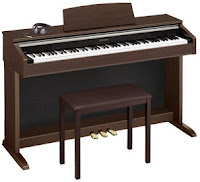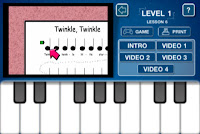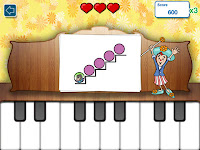 |
| Casio AP250 |
UPDATED REVIEW – December 1, 2017 – Casio AP250/260 Digital Piano – Recommended – Both the Casio AP250 furniture digital piano ($849 internet
discount price) and the AP260 ARE NOW DISCONTINUED and the replacement is called the AP270 which is a very big upgrade to the former models in terms of a much more realistic piano playing experience. Read my new detailed review of the Casio AP270 at the following link: Casio AP270 Review
Even though the much older and out of date AP250 has been discontinued in the mainstream market for a number of years, it may still be sold by a couple of places on-line including Costco. The Costco selloff price for the AP250 during this month of December is $699 plus sales tax while supplies last. However the brand new 2018 model AP270 (available in 2 colors along with factory 5 year parts & labor warranty) is on a limited time introductory sale (while supplies last) that puts it much closer in price to the older AP250 on sale at Costco incl free shipping, no tax, so please ask me about this intro price before you buy anything anywhere.
Previous review for AP250: The Casio AP250 was (is) a good piano for its lower price because
it offered a pretty nice piano playing experience in a lower price range under $1000 for graded hammer weighted style key action movement, a full size 3-pedal unit for traditional piano pedaling, and acoustic piano
tone realism in a smaller size traditional furniture style cabinet with a metal
sliding key cover. The AP250 cabinet is also fairly lightweight with stand and pedals (only 87 lbs).
The
Casio company itself is based in Tokyo, Japan (left pic) and has been
producing digital pianos and musical instruments including digital
keyboards, synthesizers, pianos, guitars, and other sophisticated
musical instruments for over 30 years, which is a long time in my
opinion. They are obviously also well known for their keyboards,
watches, digital cameras, calculators, and hundreds of other digital
products so technology is not new to them. Casio is generally thought of
as a company that gives you a lot of “bang for the buck” in the lower
price ranges and it’s certainly true for the AP250 in my opinion. By the
way, all Casio digital pianos come with a long 3 year parts and labor
factory warranty, and are fairly reliable based on my personal
experience as well as other people I know who own Casio pianos. Copyright
I have played the AP250 and like the way it plays and sounds in this price range. I have played other digital pianos that I like better in terms of key action, sound, and pedaling realism, but they are a bit more money. The main control panel buttons on the AP250 are easy to see and located in front of you across the top although there are a lot of people out there who may prefer the piano to look less cluttered and more minimalistic than they way the AP250 looks. The piano has 18 nice instrument
tones including strings, harpsichord, organ, electric pianos, etc, five of which are various sounding acoustic pianos
which is one of the most important features to have on a digital piano. A
good variety of acoustic piano tones allows you to play and reproduce
different types of piano music including classical, jazz, pop, country,
etc. Also,
the piano’s ability to play higher levels of music is always better when there is more piano sound
computer memory (called polyphony) and the AP250 has 128-note polyphony which is good in this price range, but the new AP270 has 192 notes of polyphony memory which helps generate a much better, more natural piano sound (Yamaha & Roland also have 128-note polyphony).
It’s generally good to get more polyphony than less. Having
more polyphony memory also helps with getting more realistic pedal decay
time when sustaining multiple notes from the keys. Using the
pedals (especially the right sustain pedal) is an important aspect of piano playing and this would
include having good, resonate pedal sustain reproduction instead of
just on & off sustain as is in many other digital pianos and
keyboards such as Kurzweil, Galileo, etc which don’t have variable length sustain. The more authentic pedal sustain reproduction is also known as
“half-damper pedaling” and the AP250 has that feature which is
important as your playing skill level increases. All regular acoustic
pianos have a “gradual sustain” pedaling (the right pedal) so getting
“half-damper” pedal sustain on your digital piano is a good thing, especially as you progress in your musical playing ability.
As
far as key action movement and dynamic response goes, the AP250 is quite good for its low
price and I was fairly impressed when I played it. Key action is always the number one concern of piano
teachers and those people who can play piano at higher skill levels. Many people ask me “does this digital piano feel and respond like a
real acoustic piano?” My answer is that most brands and models of
real acoustic pianos feel and play differently from each other
including uprights & grands. There are different price ranges
and qualities just like in anything you can buy, so the AP250 is not
going to be replacing a Steinway grand piano anytime soon:) However, for
its price range it is a good piano in being able to reproduce a fairly realistic
acoustic upright piano playing experience with graded hammer weighted action, good tonal dynamics, and smooth
volume response, although I have heard better.
| Casio AP250 keyboard |
As far as the piano keys themselves go, the various
digital manufacturers have come out with new synthetic “ivory feel”
keytops on many digital pianos which is a new material on top of the
white keys that tries to reproduce the original real ivory keys that
used to be on most acoustic pianos many years ago until it became
illegal to use elephant ivory. The ivory substance provided a better
playing experience for most people because it helped absorb the sweat your
fingers would produce while playing the keys and this material also
provided a smoother key surface as well. Also, the black key tops of acoustic pianos were
made of ebony (have you heard the term ebony & ivory?) so the
black keys also had a better playing surface. To get these new keytops (ivory only)
instead of the regular plastic ones, you would need to spend more money in the Yamaha, Kawai, or Roland furniture cabinet brands. Beyond that,
this new material is not the same on every piano brand because some
are better than others. Casio has added a proprietary
synthetic ebony and ivory texture to their keys that I personally like and it has a noticeable texture, although it may feel a bit different to people than regular new acoustic pianos and some people have a more difficult time getting used to this synthetic textured material on the keytops.
 Beyond
Beyond
the piano playing experience, having some useful digital features in
the piano that can help with music education and/or playing skills, etc,
is always welcome as far as I’m concerned. As a piano teacher &
musician I enjoy having these features on my digital pianos and like to
see students and recreational piano players get them too. The AP250 has a class compliant USB MIDI connection to computer or iPad device
which is very useful for interactive play and learning for both children & adults. I use iPad piano & music learning apps in my studio all the time for students because the visual interaction between the piano and the iPad app is really cool and can help get the point across that I am trying to make to the student in ways that nothing else can. There are great iPad/tablet apps out there for both kids & adults (left pics) to take advantage of this new
technology as well as useful piano music notation programs for laptop computers so
that you can have a fun interactive time in learning, composing, on
screen notation & music creation.The AP250 can also electronically split the keyboard into 2 equal parts
for duet play for teaching and learning having both sides of the keyboard be the same octave, and there are functions that
allow for the layering or splitting two different sounds at the same time like having an acoustic piano sound & string sound together playing at the same time or selecting a different sound on
the left hand and a different sound on the right hand, which is pretty cool. The piano also has a 2-track 1-song recorder for recording left & right hand independently for playback separately or together so you can hear how you did…some people don’t want to hear themselves but it really is a good thing to do:). The AP250 also has a key transpose feature to electronically put your song in any key no matter what key you’re actually playing it in (great for singing) as well as a number of other useful functions including metronome, key sensitivity control, brightness control, and other useful features.
Overall for the money, the Casio AP250 is a digital piano which most people will enjoy while keeping the price down to under $1000 in a traditional cabinet design along with a sliding key cover, headphone jacks, fairly realistic acoustic piano sound, graded weighted key action, and
useful on-board digital features. I recommend you do your piano research and homework because spending around $1000US is a lot of money and you want to be sure you are making a good buying decision and that you are getting the most for the money. You will likely have the piano for many years so sometimes just spending a bit more money on a next model up can be a better long term investment and the extra dollars spent now can take you further into your musical future. Please contact me before you spend your hard earned money and I will be happy to give you some helpful advice.
If you want more info on these and other pianos and lower prices than internet or store discounts including Amazon, please email me at tim@azpianowholesale.com or call me direct at 602-571-1864
















Great post. Do the Celvianos have the same key action and sound engines as the Privias?
The new Casio Privia's and Celviano's have identical key actions
do you recommend the PX780 to the AP250?
that's an easy one to answer…aside from cabinet, the Casio PX780 would be my personal choice. If you want more detailed info on why that is, please email me directly.
Tim, thanks for your review. I need to decide between Privia PX750, Celviano AP-250, and Yamaha YDP-162. Price is similar for these models. What do you recommended?
Thanks in advance.
Hi Tim, thanks for this excellent review. Would your personal choice still be the PX780 over an AP650?
Thank you,
Gerardo
yes it would, especially for the cost savings
Very helpful review for the beginners thinking of purchasing a lower priced piano. Thanks for the detailed explanation.
Great post. How different is this from the previous discontinued model Celviano 220 BK? Costco has the Celviano 220 BK on sale this week for $700 with the stand and bench, so I was just wondering. It seems like a great deal, but I'm not sure if it is not as good as the 250 model.
Casio has a new piano called the PX750 which has an internet discount price of $799 and this model is much better in piano sound realism and key action movement than the discontinued Casio AP220. The new AP250 is the direct replacement of the discontinued AP220 and the AP250 is also much better in terms of key action and piano sound realism (and also ivory touch keytops) than the AP220. It depends on how long you intend to keep the piano and if you want the better piano playing realism.
AP 720 for $999 or PX 850 for $1099 – based on your review I think the latter would be the best choice
Thank you for the review 😀
Your reviews are extremely helpful and I was hoping you could assist me further in guiding me towards the best piano for my needs as I am still completely undecided. I have never played the piano before and am now looking to take it up now that I have some spare time in my hectic life. Given that I am only starting out I have been drawn towards a digital piano, predominately for cost, and secondly as I can practice quietly once the kids are asleep. I don’t have a great budget and was drawn towards the Casio AP-245. Do you think this would be a wise investment given I’m only starting out or would you suggest I pay that bit more for the PX750 or more again for the PX780. Is there enough difference between the AP245 and PX750 (or PX780) to justify the extra cost at this early stage.
Tim, do you have review of AP450 and AP650? so hard for me here to find PX 850 in my area, types left only AP250, AP450, PX150 and PX350.
Px-750 or AP-250?
Would you recommend Casio AP 260 or Kawai CE 220?